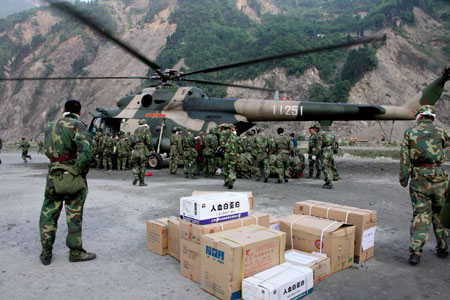Quake tests military's combat capability
(Xinhua)
Updated: 2008-06-10 19:02
Updated: 2008-06-10 19:02
BEIJING - After 10 days of search, remains of the missing Chinese helicopter and those aboard were found on a mountain near the epicenter Yingxiu Town on Tuesday.
 Soldiers unload emergency relief goods from a military helicopter in Yingxiu Town of Wenchuan County, Southwest China's Sichuan Province, May 15, 2008. [Xinhua]
|
The debris of the Mi-171 helicopter was found in the bushes northwest of Yingxiu at 10:55 a.m. Tuesday. On May 26, five days' before the crash, Senior Colonel Qiu Guanghua, the helicopter pilot, described that the aftermath of the quake resembled a war in an interview with China National Radio.
"I have joined in several disaster relief operations, but this time so many people died or were injured," the 51-year-old said. "All Chinese people are mobilized to support the quake-hit regions and some even sacrificed their lives."
"The aftermath of the earthquake looks like a war and it is a test for the Chinese armed forces."
After 29 years of peace in the country, the Chinese armed forces are now engaging in a war against the devastating earthquake.
From devastating floods in the Yangtze and Songhuajiang rivers in 1998 to heavy snowstorms in south China at the beginning of this year, the Chinese military had always acted as the main force for disaster rescue and relief. In the meantime, disasters had tested the Chinese forces' combat capability during the time of peace.
On May 12, 13 minutes after the 8.0-magnitude quake struck the southwestern Sichuan Province and neighboring regions, Chinese armed forces started their emergency response system. The first Chinese military rescue team headed for the disaster area within 14 minutes. In less than 10 hours after the quake, 12,000 armed forces and armed police arrived at the quake-battered areas for rescue.
About 130,000 soldiers of the Chinese army, navy and air force were currently working in the quake-hit regions in rescue and relief. Soldiers trained in over 20 specialties, including quake rescue, scouting and engineering, among others, were sent to the quake-hit regions.
Such measures are unprecedented in Chinese military history in disaster rescue and relief, military sources said.
As of May 28, the armed forces had excavated over 3,336 survivors from the debris and evacuated over 660,000 stranded people.
In nearly one month of rescue and relief operations, the military had helped the local people to set up battlefield hospitals, schools in tents and provide psychological consultation to quake survivors.
The well-coordinated, long-range operation during the disaster rescue and relief showcased the military's strong combat capacity, military experts said.
|
||
|
||
|
|
|
|

